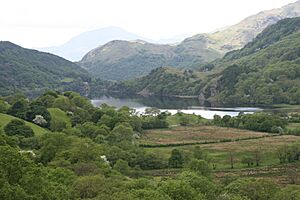Nant Gwynant facts for kids
Nant Gwynant is a beautiful valley in north Wales. A main road, the A498, winds its way down into the valley, dropping about 180 meters (600 feet) over 3 kilometers (2 miles). This road follows the Nant Cynnyd and Afon Glaslyn rivers, passing alongside the lovely Llyn Gwynant lake. It then goes beside the Nant Gwynant river to Llyn Dinas and past Dinas Emrys before reaching the village of Beddgelert. The road continues through the Aberglaslyn Pass all the way to Porthmadog.
The upper part of Nant Gwynant starts near where a Roman fort and marching camp once stood. This is where the modern A4086 road (from Caernarfon to Capel Curig) meets the valley. From here, the valley follows the Nant Cynnyd river. About a mile along, you can find a great viewpoint overlooking the Cwm Dyli hydro-electric power station. This power station was built over 100 years ago! It uses water from Llyn Llydaw lake to create electricity for the National Grid (UK), which powers homes and businesses across the country.
A bit further, you'll pass Hafod Lwyfog, a historic summer home built in the 1540s. A famous person named Sir John Williams, who was a goldsmith for King James I, was born here. In 1938, the owner at the time, Clough Williams-Ellis, gave part of this land to the National Trust. He did this because he hoped the Snowdonia National Park would be created soon, which it was! Today, there's a campsite at the top of Llyn Gwynant, and Sir Clough Williams-Ellis's family still looks after the rest of the farm as a special conservation area.
Contents
Exploring the Valley
Between the two lakes, Llyn Gwynant and Llyn Dinas, is a place called Hafod-y-Llan. The National Trust bought this land in 1998. Here, you can find the start of the Watkin Path. This path climbs up above the Afon Cwm Llan river all the way to the top of Snowdon, which is the highest mountain in Wales! The path begins near an old quarry called South Snowdon Quarry.
The Watkin Path was officially opened in 1892 by William Ewart Gladstone, who was the Prime Minister of the UK at the time. It was specially built for Sir Edward Watkin. He was a railway builder and a Victorian pioneer who even worked on ideas for the Channel Tunnel between England and France! He built the path for his guests at The Chalet, his summer home in the woods.
Another property owned by the National Trust in the valley is Craflwyn. It sits below the hill of Dinas Emrys. According to old stories, an unhappy king named Vortigern came here with his advisor, Myrddin Emrys. King Vortigern was a Romano-British King who first met the Anglo Saxon people arriving in Britain.
Fun Activities in Nant Gwynant
Nant Gwynant is a great place for outdoor activities!
Watersports on Llyn Gwynant
Llyn Gwynant is a popular spot for watersports, just like many other lakes in north Wales. Local schools and groups often use it for activities like kayaking, canoeing, and paddleboarding. You can easily get to the water from the car park next to the road.
Climbing at Clogwyn y Wenallt
At the eastern end of the valley, there's a rocky cliff called Clogwyn y Wenallt. This place is known for its challenging climbing routes. One famous route is called 'Lockwoods Chimney'. It's named after Arthur Lockwood, who became the owner of the Pen-y-Gwryd hotel in 1921. That hotel is just a mile further up the valley.
Camping in the Valley
If you love camping, Nant Gwynant has some great options. There's a campsite right by the lake at the north-east end of Llyn Gwynant. The National Trust also has a campsite at Hafod y Llan, which is a lovely spot to stay and explore the area.


